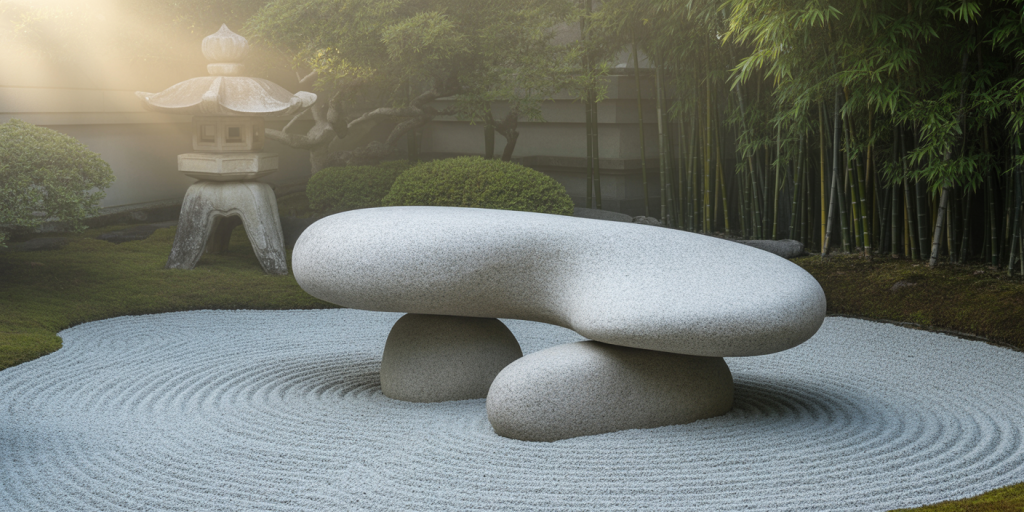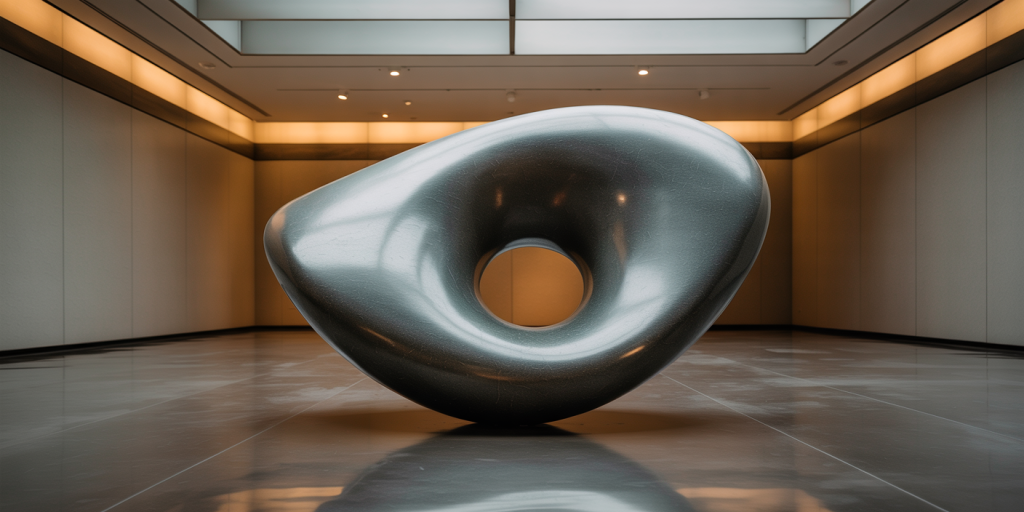Isamu Noguchi and the Stones That Learned to Float
Like whispers from the earth softened by the breath of wind, Isamu Noguchi’s sculptures do not shout. They hum. They ripple in silence. “Isamu Noguchi and the Stones That Learned to Float” is a contemplation, a space where gravity is questioned, and where solid form dances with the immaterial. One does not simply observe Noguchi’s work; one is drawn into it, as into a dream that remembers the body of the world.
Each stone, each curved void, each delicate lift of surface seems to carry memory — not of what has passed, but of what lies waiting in the soil, in the water, in the sky. To enter Noguchi’s world is to enter a garden without walls, where thought is as much a material as basalt or granite. And in this garden, somehow, the stones have learned to float.
Table of Contents
- The Breath Inside the Stone
- Where Silence Takes Shape
- The Poetry of Mass and Void
- Asymmetry in the Language of Balance
- When Shadows Speak Louder Than Light
- The Gravity of Grace
- Water That Does Not Wet the Stone
- The Architect of Emptiness
- Earth Anchored in Air
- The Skin of the Invisible
- The Calligraphy of Edges
- Sculpting the Unspoken
- A Garden that Dreams
- Floating Weight: A Paradox
- Noguchi and the Japanese Soul
- The Memory of Mountains
- Stones that Murmur Human Thought
- A Dialogue with Time
- The Infinite Pause
- The Artist Who Listens to Silence
The Breath Inside the Stone
A Noguchi stone is never merely hard. Within its silent core, one can feel the echo of an exhale, as though the stone remembers being water. Its surfaces, chiseled yet reverent, retain the illusion of breath — a whisper trapped in mineral. Noguchi doesn’t shape stone to impose; he releases.
The artist believed in collaboration with material. The breath, therefore, is mutual: the artist breathes into the stone only what the stone already knows. This creates sculptures that seem alive without animation.
Where Silence Takes Shape
Silence in Noguchi’s work is not void but presence. It is shaped, composed, given edge and weight. Like a silent bell, his forms ring through their stillness.
In works like Black Sun or Stone of Sky, silence manifests not as absence, but as an active companion to form. One cannot escape the sensation that this silence is watching, listening.
The Poetry of Mass and Void
Mass and emptiness are lovers in Noguchi’s syntax. One invites the other, and both are incomplete alone. A boulder with a hollow becomes a portal; a void framed by granite becomes an invitation.
The weight of the object does not weigh down the spirit. On the contrary, the juxtaposition of mass and void creates uplift. It is here the stones begin to float.
Asymmetry in the Language of Balance
There is an elegance to imbalance that Noguchi understood deeply. Asymmetry does not imply chaos but rather a different harmony — one rooted in natural growth, in the tilt of trees, the flow of rivers.
Each stone, carefully unbalanced, speaks of movement, of time folding into form. Noguchi draws balance not by symmetry but by dialogue between parts.
When Shadows Speak Louder Than Light
Light is often a sculptor’s ally, but Noguchi gave equal voice to shadow. The hollows and undulations in his pieces collect darkness like ink, writing poems across the floor.
It is in these shadow-scripted margins that the mystery of his work unfolds. The unseen becomes the center.
The Gravity of Grace
Grace in stone seems like a contradiction until one witnesses a Noguchi sculpture. There is a softness in how the forms lean, rest, rise. It is not weakness but humility.
In To Behold the Void, the stone arcs as if bowing to its own becoming. Gravity, here, is not merely a force but a presence to be danced with.
Water That Does Not Wet the Stone
Noguchi often evoked water without moisture. The curves, the sinuous embrace of planes, the rhythmic indentations all recall riverbeds and tides.
In some installations, actual water flows. But more often, it is imagined — the stone becomes a memory of current. We feel the wash without getting wet.
The Architect of Emptiness
Few artists shape emptiness as Noguchi does. He builds nothingness like an architect, giving structure to air. His voids are spaces to enter, mentally and spiritually.
These emptinesses are not emptiness at all. They are thresholds, meanings waiting to be discovered in the pause between thoughts.
Earth Anchored in Air
To see a 300-pound stone appear to levitate is to understand Noguchi’s genius. Through cantilevering, unexpected supports, and psychological misdirection, he tricks the eye — and frees the soul.
These suspended forms recall kites made of rock, or prayers that never landed. They are impossible and yet entirely true.
The Skin of the Invisible
Texture plays an emotional role in his work. Rough granite sings differently than polished obsidian. A groove in the surface becomes a wrinkle in time.
Running a hand along these sculptures, one does not touch stone but the memory of the tools, the labor, the intention. The invisible hand becomes present.
The Calligraphy of Edges
Edges in Noguchi’s work are not sharp declarations, but brushstrokes. They are soft, curved, folded, torn. They do not confine, they suggest.
His stonework feels written more than built. Each contour is a syllable in a visual poem. It is not read; it is absorbed.
Sculpting the Unspoken
There are no manifestos in Noguchi’s practice, only murmurs. His art does not shout its meaning. Instead, it gestures toward it, asking you to bring your silence.
What is left unspoken is what fills the space between sculpture and viewer. It is a co-creation of understanding.
A Garden that Dreams
His garden designs — particularly in Kyoto and at the Noguchi Museum — are not landscapes but dreamscapes. They blend architecture, sculpture, and absence.
Stones are placed like notes in a song only the wind can hear. The garden becomes an orchestration of stillness.
Floating Weight: A Paradox
This is the heart of Noguchi’s magic: to make what is heavy feel light. To make permanence feel like a breath.
This is not illusion. It is empathy. The floating stone teaches us how to live with grace, even while rooted.

Noguchi and the Japanese Soul
Though born in the United States, Noguchi’s heart was deeply entwined with Japan. The aesthetics of Zen, of wabi-sabi, of Noh theater and calligraphy shaped his intuition.
His work is not about identity, but about essence. About the soul’s shape when it listens instead of speaks.
The Memory of Mountains
Many of his pieces feel like mountain fragments — not broken, but extracted with reverence. They carry the solemnity of age.
In viewing them, one feels time slowing. The mountain speaks, and it speaks in stone.
Stones that Murmur Human Thought
There is something human in these objects. A tilt of stone that mimics a bow, a hole that suggests an eye, a curve like a hand at rest.
Noguchi anthropomorphizes without figurating. His works murmur of human presence without depicting it.

A Dialogue with Time
His sculptures feel ancient and modern simultaneously. They could belong to a prehistoric altar or a future shrine.
This temporal ambiguity makes them timeless. They are not anchored in chronology, but in the continuity of feeling.
The Infinite Pause
A Noguchi piece invites stillness. Not passive stillness, but alert. The kind of stillness before a word is spoken, or just after a note fades.
It is here, in this infinite pause, that the floating stone resides. Neither here nor there, but present.

The Artist Who Listens to Silence
Noguchi was less a sculptor of things and more a sculptor of relations. Of how shadow meets edge, how gravity speaks to air.
He listened to silence and carved it. He listened to the world and replied with form. His works are conversations, not declarations.
FAQ
Q: Who was Isamu Noguchi?
A: Isamu Noguchi (1904–1988) was a Japanese-American sculptor and designer renowned for his organic, abstract forms and innovative integration of art, architecture, and landscape. His works range from stone sculptures to furniture and public parks.
Q: What materials did Noguchi often use?
A: He frequently worked with basalt, granite, marble, and other natural stones, as well as wood, metal, and even paper in his Akari light sculptures.
Q: What philosophies influenced his work?
A: Zen Buddhism, wabi-sabi, traditional Japanese aesthetics, modernism, and a respect for natural forms heavily shaped his artistic vision.
Q: Why do his sculptures appear to float?
A: Through careful balance, spatial composition, and illusion, Noguchi achieved a sense of weightlessness that defies the material mass of his sculptures.
Q: Where can I see his work today?
A: The Noguchi Museum in New York, the UNESCO Garden in Paris, and various public installations and collections worldwide preserve and exhibit his legacy.
Notes from the Stone Garden
To walk among Noguchi’s sculptures is to forget the difference between stone and breath. Between body and space. His is an art of empathy and listening, where heaviness becomes hope, and silence becomes music.
The stones that learned to float do not perform miracles. They remind us that the miracle is already here: in the touch, in the pause, in the shadow that moves with us. In the weight we carry with grace.
Noguchi does not offer answers. He offers places to begin listening.
